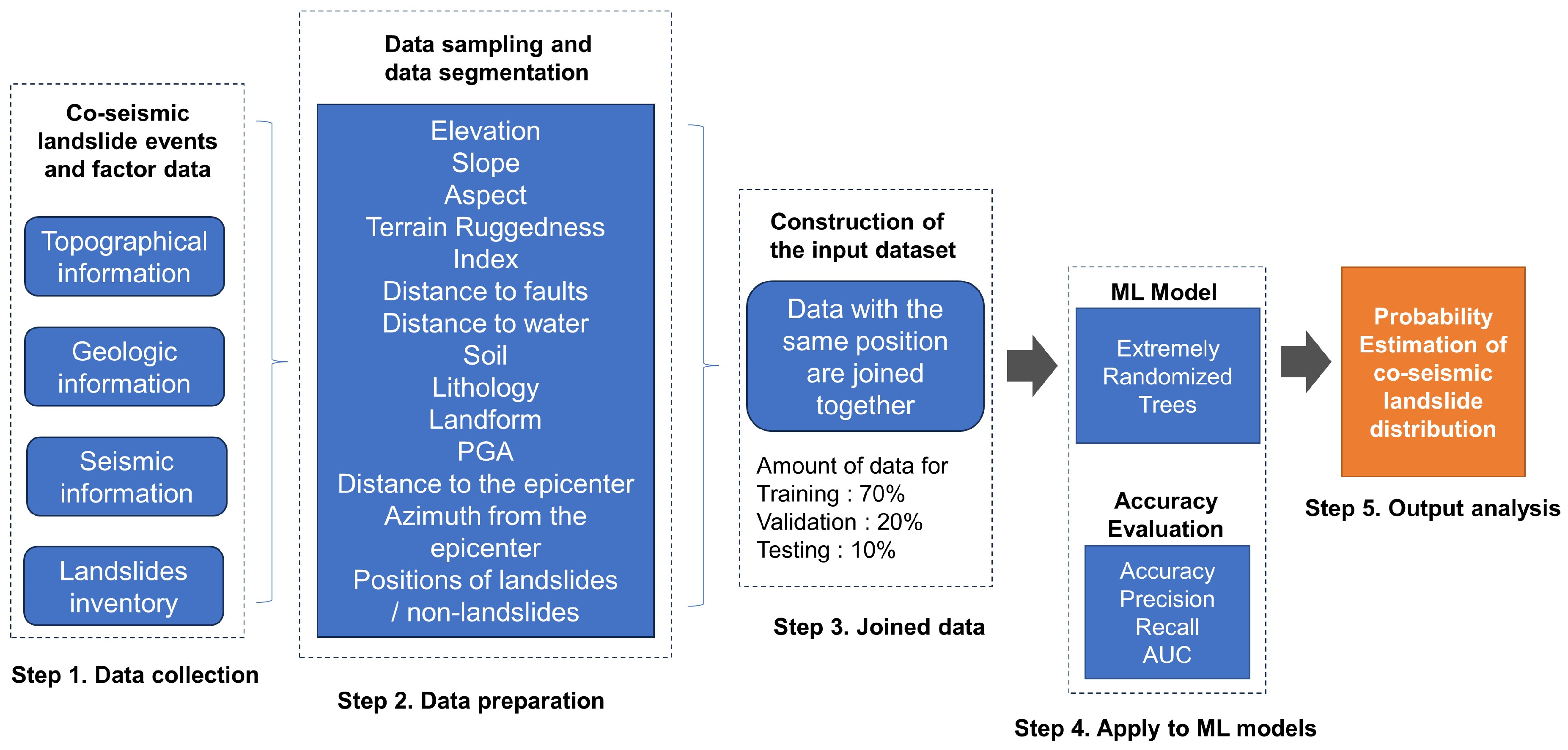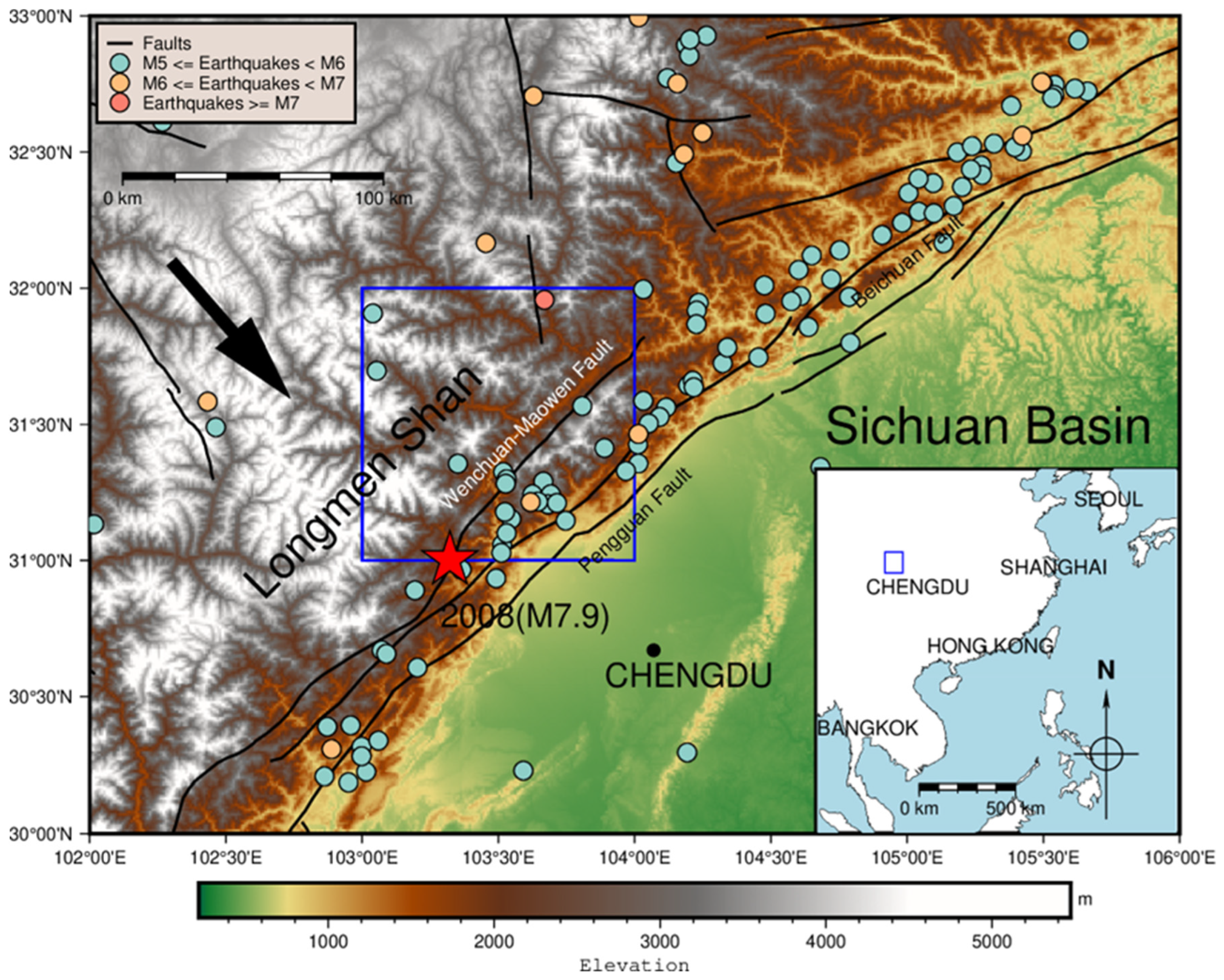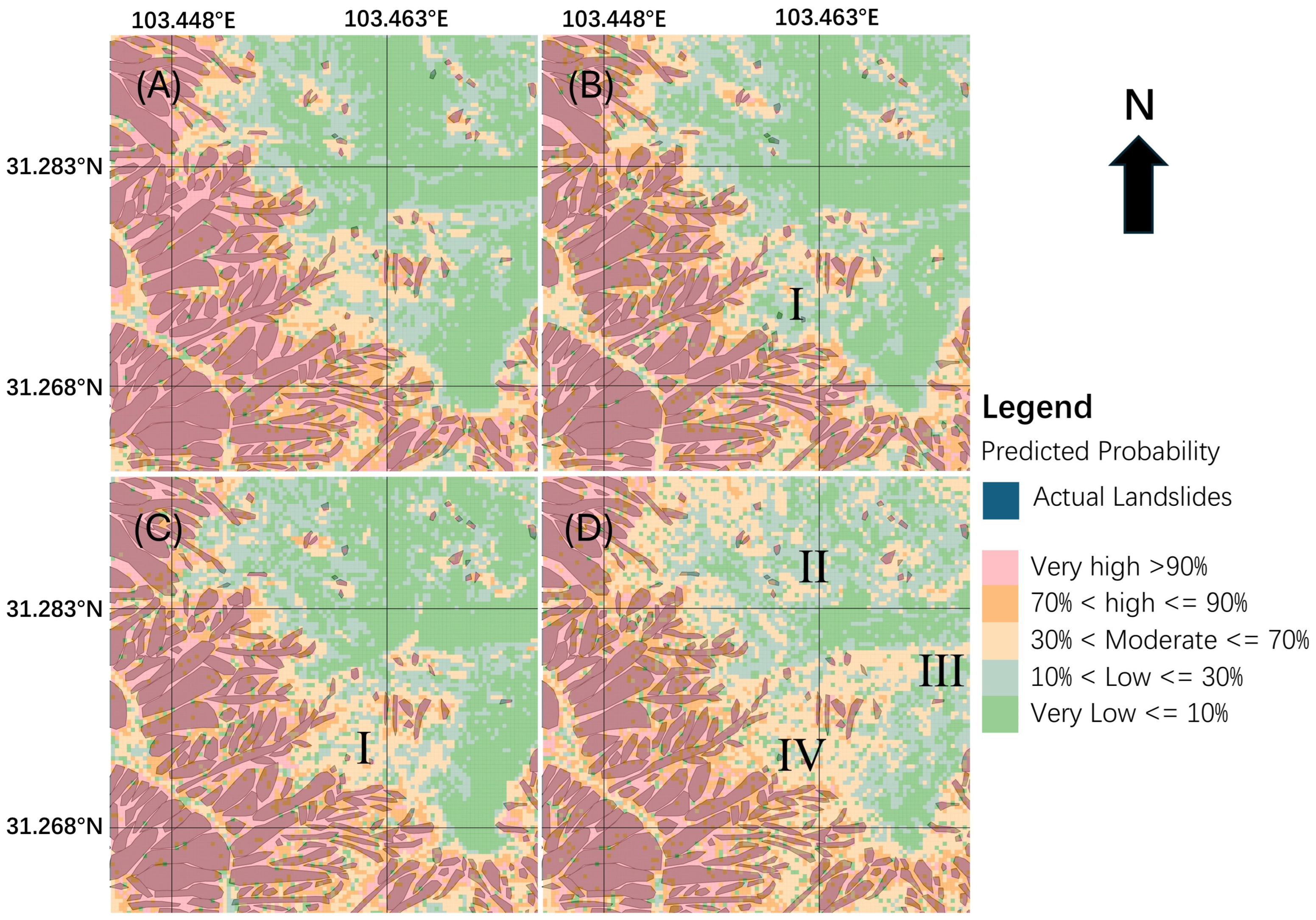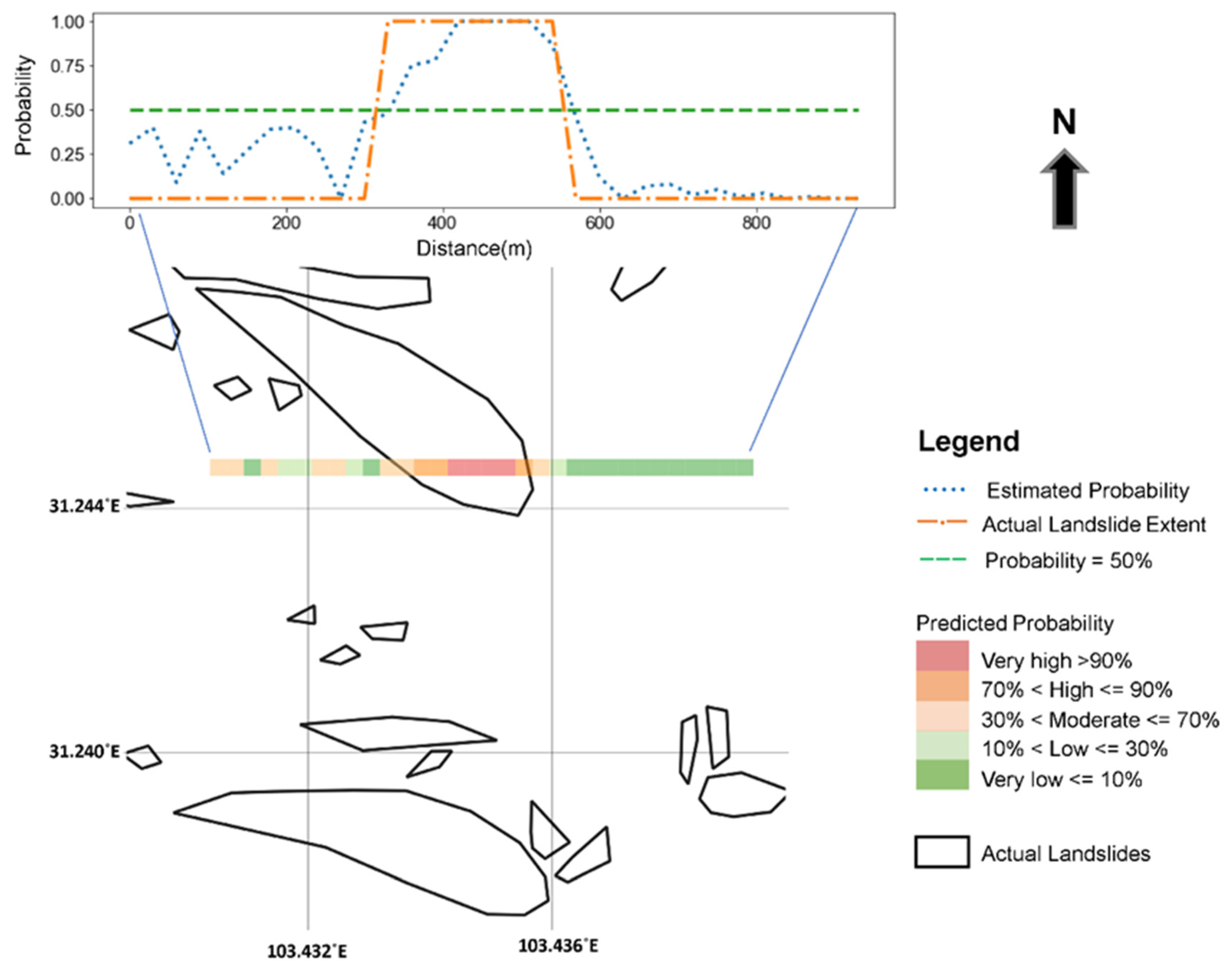Machine Learning Prediction of Co-Seismic Landslide with Distance and Azimuth Instead of Peak Ground Acceleration
Abstract
1. Introduction
2. Methods and Data
2.1. Modeling Approach
2.2. Model Performance Assessment
2.3. Extremely Randomized Trees
2.4. Study Area and Data
2.4.1. Overview of the Study Area
2.4.2. Landslide Data
2.4.3. Environmental Factor Data
2.5. Training, Validation, and Test Data
2.6. Different Model Construction Schemes
3. Results
3.1. Prediction Performance
3.2. Landslides Prediction Results
4. Discussion
5. Conclusions
Author Contributions
Funding
Institutional Review Board Statement
Informed Consent Statement
Data Availability Statement
Acknowledgments
Conflicts of Interest
References
- Dai, F.C.; Lee, C.F.; Ngai, Y.Y. Landslide risk assessment and management: An overview. Eng. Geol. 2002, 64, 65–87. [Google Scholar] [CrossRef]
- Hermanns, R.L. Landslide. In Encyclopedia of Engineering Geology; Bobrowsky, P.T., Marker, B., Eds.; Springer International Publishing: Cham, Switzerland, 2018; pp. 579–580. [Google Scholar] [CrossRef]
- Malamud, B.D.; Turcotte, D.L.; Guzzetti, F.; Reichenbach, P. Landslide inventories and their statistical properties. Earth Surf. Process. Landf. 2004, 29, 687–711. [Google Scholar] [CrossRef]
- Dai, F.C.; Lee, C.F.; Deng, J.H.; Tham, L.G. The 1786 earthquake-triggered landslide dam and subsequent dam-break flood on the Dadu River, southwestern China. Geomorphology 2005, 65, 205–221. [Google Scholar] [CrossRef]
- Zhou, J.-w.; Cui, P.; Fang, H. Dynamic process analysis for the formation of Yangjiagou landslide-dammed lake triggered by the Wenchuan earthquake, China. Landslides 2013, 10, 331–342. [Google Scholar] [CrossRef]
- Keefer, D.K.; Larsen, M.C. Assessing Landslide Hazards. Science 2007, 316, 1136–1138. [Google Scholar] [CrossRef]
- Gorum, T.; Fan, X.; van Westen, C.J.; Huang, R.Q.; Xu, Q.; Tang, C.; Wang, G. Distribution pattern of earthquake-induced landslides triggered by the 12 May 2008 Wenchuan earthquake. Geomorphology 2011, 133, 152–167. [Google Scholar] [CrossRef]
- Hungr, O.; McDougall, S. Two numerical models for landslide dynamic analysis. Comput. Geosci. 2009, 35, 978–992. [Google Scholar] [CrossRef]
- Carrara, A.; Cardinali, M.; Detti, R.; Guzzetti, F.; Pasqui, V.; Reichenbach, P. GIS techniques and statistical models in evaluating landslide hazard. Earth Surf. Process. Landf. 1991, 16, 427–445. [Google Scholar] [CrossRef]
- Lee, C.-T.; Huang, C.-C.; Lee, J.-F.; Pan, K.-L.; Lin, M.-L.; Dong, J.-J. Statistical approach to earthquake-induced landslide susceptibility. Eng. Geol. 2008, 100, 43–58. [Google Scholar] [CrossRef]
- Guzzetti, F.; Carrara, A.; Cardinali, M.; Reichenbach, P. Landslide hazard evaluation: A review of current techniques and their application in a multi-scale study, Central Italy. Geomorphology 1999, 31, 181–216. [Google Scholar] [CrossRef]
- Xu, C.; Xu, X.W.; Dai, F.C.; Saraf, A.K. Comparison of different models for susceptibility mapping of earthquake triggered landslides related with the 2008 Wenchuan earthquake in China. Comput. Geosci. 2012, 46, 317–329. (In English) [Google Scholar] [CrossRef]
- Tien Bui, D.; Tuan, T.A.; Klempe, H.; Pradhan, B.; Revhaug, I. Spatial prediction models for shallow landslide hazards: A comparative assessment of the efficacy of support vector machines, artificial neural networks, kernel logistic regression, and logistic model tree. Landslides 2016, 13, 361–378. [Google Scholar] [CrossRef]
- Dou, J.; Yunus, A.P.; Tien Bui, D.; Merghadi, A.; Sahana, M.; Zhu, Z.; Chen, C.-W.; Khosravi, K.; Yang, Y.; Pham, B.T. Assessment of advanced random forest and decision tree algorithms for modeling rainfall-induced landslide susceptibility in the Izu-Oshima Volcanic Island, Japan. Sci. Total Environ. 2019, 662, 332–346. [Google Scholar] [CrossRef] [PubMed]
- Merghadi, A.; Yunus, A.P.; Dou, J.; Whiteley, J.; ThaiPham, B.; Bui, D.T.; Avtar, R.; Abderrahmane, B. Machine learning methods for landslide susceptibility studies: A comparative overview of algorithm performance. Earth Sci. Rev. 2020, 207, 103225. [Google Scholar] [CrossRef]
- Fan, X.; Fang, C.; Dai, L.; Wang, X.; Luo, Y.; Wei, T.; Wang, Y. Near real time prediction of spatial distribution probability of earthquake-induced landslides—Take the lushan earthquake on June 1, 2022 as an example. J. Eng. Geol. 2022, 30, 729–739. [Google Scholar] [CrossRef]
- Liu, R.; Yang, X.; Xu, C.; Wei, L.S.; Zeng, X.Q. Comparative Study of Convolutional Neural Network and Conventional Machine Learning Methods for Landslide Susceptibility Mapping. Remote Sens. 2022, 14, 321. [Google Scholar] [CrossRef]
- Sun, X.H.; Yu, C.L.; Li, Y.R.; Rene, N.N. Susceptibility Mapping of Typical Geological Hazards in Helong City Affected by Volcanic Activity of Changbai Mountain, Northeastern China. Isprs Int. J. Geo-Inf. 2022, 11, 344. [Google Scholar] [CrossRef]
- Wang, X.; Wang, X.; Zhang, X.; Wang, L.; Guo, H.; Li, D. Near real-time spatial prediction of earthquake-induced landslides: A novel interpretable self-supervised learning method. Int. J. Digit. Earth 2023, 16, 1885–1906. [Google Scholar] [CrossRef]
- Su, L.Y.; Gui, Y.N.; Xu, L.; Ming, D.P. Rain-Induced Landslide Hazard Assessment Using Inception Model and Interpretability Method—A Case Study of Zayu County, Tibet. Appl. Sci. Basel 2024, 14, 5324. [Google Scholar] [CrossRef]
- Dai, F.C.; Xu, C.; Yao, X.; Xu, L.; Tu, X.B.; Gong, Q.M. Spatial distribution of landslides triggered by the 2008 Ms 8.0 Wenchuan earthquake, China. J. Asian Earth Sci. 2011, 40, 883–895. [Google Scholar] [CrossRef]
- Dai, L.; Fan, X.; Wang, X.; Fang, C.; Zou, C.; Tang, X.; Wei, Z.; Xia, M.; Wang, D.; Xu, Q. Coseismic landslides triggered by the 2022 Luding Ms6.8 earthquake, China. Landslides 2023, 20, 1277–1292. [Google Scholar] [CrossRef]
- Fan, X.; Scaringi, G.; Korup, O.; West, A.J.; van Westen, C.J.; Tanyas, H.; Hovius, N.; Hales, T.C.; Jibson, R.W.; Allstadt, K.E.; et al. Earthquake-Induced Chains of Geologic Hazards: Patterns, Mechanisms, and Impacts. Rev. Geophys. 2019, 57, 421–503. [Google Scholar] [CrossRef]
- Fan, X.; Yunus, A.P.; Scaringi, G.; Catani, F.; Siva Subramanian, S.; Xu, Q.; Huang, R. Rapidly Evolving Controls of Landslides After a Strong Earthquake and Implications for Hazard Assessments. Geophys. Res. Lett. 2021, 48, e2020GL090509. [Google Scholar] [CrossRef]
- Xu, C.; Xu, X.; Shyu, J.B.H.; Gao, M.; Tan, X.; Ran, Y.; Zheng, W. Landslides triggered by the 20 April 2013 Lushan, China, Mw 6.6 earthquake from field investigations and preliminary analyses. Landslides 2015, 12, 365–385. [Google Scholar] [CrossRef]
- Xu, C.; Xu, X.; Wu, X.; Dai, F.; Yao, X.; Yao, Q. Detailed catalog of landslides triggered by the 2008 wenchuan earthquake and statistical analyses of their spatial distribution. J. Eng. Geol. 2013, 21, 25–44. [Google Scholar]
- Xu, C.; Xu, X.; Yao, X.; Dai, F. Three (nearly) complete inventories of landslides triggered by the May 12, 2008 Wenchuan Mw 7.9 earthquake of China and their spatial distribution statistical analysis. Landslides 2014, 11, 441–461. [Google Scholar] [CrossRef]
- Xu, C.; Xu, X.; Yu, G. Landslides triggered by slipping-fault-generated earthquake on a plateau: An example of the 14 April 2010, Ms 7.1, Yushu, China earthquake. Landslides 2013, 10, 421–431. [Google Scholar] [CrossRef]
- Xu, C.; Xu, X.W.; Lee, Y.H.; Tan, X.B.; Yu, G.H.; Dai, F.C. The 2010 Yushu earthquake triggered landslide hazard mapping using GIS and weight of evidence modeling. Environ. Earth Sci. 2012, 66, 1603–1616. [Google Scholar] [CrossRef]
- Marc, O.; Meunier, P.; Hovius, N. Prediction of the area affected by earthquake-induced landsliding based on seismological parameters. Nat. Hazards Earth Syst. Sci. 2017, 17, 1159–1175. [Google Scholar] [CrossRef]
- Meunier, P.; Hovius, N.; Haines, A.J. Regional patterns of earthquake-triggered landslides and their relation to ground motion. Geophys. Res. Lett. 2007, 34, L20408. [Google Scholar] [CrossRef]
- Xin, D.; Zhang, Z. On the Comparison of Seismic Ground Motion Simulated by Physics-Based Dynamic Rupture and Predicted by Empirical Attenuation Equations. Bull. Seismol. Soc. Am. 2021, 111, 2595–2616. [Google Scholar] [CrossRef]
- Aki, K.; Richards, P.G. Quantitative Seismology. In Elastic Waves from a Point Dislocation Source, 2nd ed.; Ellis, J., Ed.; University Science Books: Herndon, VA, USA, 2002; pp. 63–117. [Google Scholar]
- Boore, D.M.; Atkinson, G.M. Ground-Motion Prediction Equations for the Average Horizontal Component of PGA, PGV, and 5%-Damped PSA at Spectral Periods between 0.01 s and 10.0 s. Earthq. Spectra 2008, 24, 99–138. [Google Scholar] [CrossRef]
- Campbell, K.W.; Bozorgnia, Y. NGA Ground Motion Model for the Geometric Mean Horizontal Component of PGA, PGV, PGD and 5% Damped Linear Elastic Response Spectra for Periods Ranging from 0.01 to 10 s. Earthq. Spectra 2008, 24, 139–171. [Google Scholar] [CrossRef]
- Li, X.; Zhou, Z.; Yu, H.; Wen, R.; Lu, D.; Huang, M.; Zhou, Y.; Cu, J. Strong motion observations and recordings from the great Wenchuan Earthquake. Earthq. Eng. Eng. Vib. 2008, 7, 235–246. [Google Scholar] [CrossRef]
- Zhang, W.; Shen, Y.; Chen, X. Numerical simulation of strong ground motion for the Ms8.0 Wenchuan earthquake of 12 May 2008. Sci. China Ser. D Earth Sci. 2008, 51, 1673–1682. [Google Scholar] [CrossRef]
- Fan, X.; Scaringi, G.; Xu, Q.; Zhan, W.; Dai, L.; Li, Y.; Pei, X.; Yang, Q.; Huang, R. Coseismic landslides triggered by the 8th August 2017 Ms 7.0 Jiuzhaigou earthquake (Sichuan, China): Factors controlling their spatial distribution and implications for the seismogenic blind fault identification. Landslides 2018, 15, 967–983. [Google Scholar] [CrossRef]
- Sokolova, M.; Lapalme, G. A systematic analysis of performance measures for classification tasks. Inf. Process. Manag. 2009, 45, 427–437. [Google Scholar] [CrossRef]
- Fawcett, T. An introduction to ROC analysis. Pattern Recognit. Lett. 2006, 27, 861–874. [Google Scholar] [CrossRef]
- Bradley, A.P. The use of the area under the ROC curve in the evaluation of machine learning algorithms. Pattern Recognit. 1997, 30, 1145–1159. [Google Scholar] [CrossRef]
- Geurts, P.; Ernst, D.; Wehenkel, L. Extremely randomized trees. Mach. Learn. 2006, 63, 3–42. [Google Scholar] [CrossRef]
- Wei, J.; Li, Z.; Cribb, M.; Huang, W.; Xue, W.; Sun, L.; Guo, J.; Peng, Y.; Li, J.; Lyapustin, A.; et al. Improved 1 km resolution PM2.5 estimates across China using enhanced space–time extremely randomized trees. Atmos. Chem. Phys. 2020, 20, 3273–3289. [Google Scholar] [CrossRef]
- Xu, Z.Q.; Ji, S.C.; Li, H.B.; Hou, L.W.; Fu, X.F.; Cai, Z.H. Uplift of the Longmen Shan range and the Wenchuan earthquake. Episodes 2008, 31, 291–301. [Google Scholar] [CrossRef]
- Pei-Zhen, Z.; XiWei, X.U.; XueZe, W.E.N.; YongKang, R.A.N. Slip rates and recurrence intervals of the Longmen Shan active fault zone, and tectonic implications for the mechanism of the May 12 Wenchuan earthquake, 2008, Sichuan, China. Chin. J. Geophys. 2008, 51, 1066–1073. [Google Scholar]
- Xu, X.; Wen, X.; Yu, G.; Chen, G.; Klinger, Y.; Hubbard, J.; Shaw, J. Coseismic reverse- and oblique-slip surface faulting generated by the 2008 Mw 7.9 Wenchuan earthquake, China. Geology 2009, 37, 515–518. [Google Scholar] [CrossRef]
- Li, Y.; Zhang, Z.; Wang, W.; Feng, X. Rapid Estimation of Earthquake Fatalities in Mainland China Based on Physical Simulation and Empirical Statistics—A Case Study of the 2021 Yangbi Earthquake. Int. J. Environ. Res. Public Health 2022, 19, 6820. [Google Scholar] [CrossRef]
- Pelties, C.; de la Puente, J.; Ampuero, J.-P.; Brietzke, G.B.; Käser, M. Three-dimensional dynamic rupture simulation with a high-order discontinuous Galerkin method on unstructured tetrahedral meshes. J. Geophys. Res. Solid Earth 2012, 117, B02309. [Google Scholar] [CrossRef]
- Zhang, W.; Liu, Y.; Chen, X. A Mixed-Flux-Based Nodal Discontinuous Galerkin Method for 3D Dynamic Rupture Modeling. J. Geophys. Res. Solid Earth 2023, 128, e2022JB025817. [Google Scholar] [CrossRef]
- Zhang, Z.; Zhang, W.; Chen, X. Three-dimensional curved grid finite-difference modelling for non-planar rupture dynamics. Geophys. J. Int. 2014, 199, 860–879. [Google Scholar] [CrossRef]
- Dijkshoorn, J.; van Engelen, V.; Huting, J. Soil and Landform Properties for LADA Partner Countries (Argentina, China, Cuba, Senegal and The Gambia, South Africa and Tunisia); ISRIC Report 2008/06 and GLADA Report 2008/03; ISRIC—World Soil Information and FAO: Wageningen, The Netherlands, 2008; Available online: https://www.isric.org/sites/default/files/isric_report_2008_06.pdf (accessed on 23 February 2023).






| Classifer | Parameters |
|---|---|
| Extremely Randomized Trees (ERT) | bootstrap = False n_estimaters = 10 criterion = gini max_depth = None min_samples_split = 2 max_features = auto random_state = None min_impurity_split = None |
| Factor Type | Factor | Classification |
|---|---|---|
| Seismic | Peak ground acceleration (PGA) (g) | <0.1; 0.1~0.2; 0.2~0.3; 0.3~0.4; 0.4~0.5; 0.5~0.6; 0.6~0.7; 0.7~0.8; 0.8~0.9; >0.9; |
| Distance to fault (km) | <15; 15~30; 30~45; 45~60; 60~75; 75~90; 90~105; 105~120; 120~135; >135; | |
| Distance to epicenter (km) | <10; 10~20; 20~30; 30~40; 40~50; 50~60; 60~70; 70~80; 80~90; 90~100; 100~110; >110; | |
| Azimuth angle from epicenter (degree) | <30; 30~60; 60~90; 90~120; 120~150; 150~180; 180~210; 210~240; 240~270; 270~300; >300; | |
| Terrain | Elevation (m) | <500; 500~1000; 1000~1500; 1500~2000; 2500~3000; 3000~3500; 3500~4000; 4000~4500; >4500; |
| Slope angle (degree) | <10; 10~20; 20~30; 30~40; 40~50; 50~60; 60~70; 70~80; >80; | |
| Slope aspect (direction) | N; NE; E; SE; S; SW; W; NW; | |
| Distance to hydrographic networks (km) | <3; 3~6; 6~9; 9~12; 12~15; 15~18; 18~21; 21~24; >24; | |
| Terrain Ruggedness Index | <30; 30~60; 60~90; 90~120; 120~150; 150~180; 180~210; 210~240; >240; | |
| Landforms | High-gradient mountain (TM); medium-gradient hill (SH); high-gradient hill (TH); plain (LP); | |
| Geologic | Soil | Haplic Alisols (ALh); Cumulic Anthrosols (ATc); Calcaric Cambisols (CMc); Dystric Cambisols (CMd); Gelic Cambisols (CMi); Eutric Fluvisols (FLe); Haplic Greyzems (GRh); Eutric Leptosols (LPe); Gelic Leptosols (LPi); Mollic Leptosols (LPm); Haplic Luvisols (LVh); Chromic Luvisols (LVx); Dystric Podzoluvisols (PDd); Calcaric Regosols (RGc); Eutric Regosols (RGe); |
| Lithology | Granite (IA1); Basalt (IB2); Gneiss, migmatite (MA2); Slate, phyllite, pellitic rocks (MA3/MB1); Sandstone, greywacke, arkose (SC2); Siltstone, mudstone, claystone (SC3); Shale (SC4); Limestone, other carbonate rocks (SO1); Eolian unconsolidated rock (UE1); Fluvial (UF); Unconsolidated (UR1); |
| Index | ERT-A 1 | ERT-B 2 | ERT-C 3 | ERT-D 4 |
|---|---|---|---|---|
| Accuracy | 0.904 | 0.902 | 0.897 | 0.855 |
| Precision | 0.832 | 0.829 | 0.822 | 0.769 |
| Recall | 0.892 | 0.890 | 0.879 | 0.808 |
| AUC | 0.963 | 0.963 | 0.958 | 0.929 |
Disclaimer/Publisher’s Note: The statements, opinions and data contained in all publications are solely those of the individual author(s) and contributor(s) and not of MDPI and/or the editor(s). MDPI and/or the editor(s) disclaim responsibility for any injury to people or property resulting from any ideas, methods, instructions or products referred to in the content. |
© 2024 by the authors. Licensee MDPI, Basel, Switzerland. This article is an open access article distributed under the terms and conditions of the Creative Commons Attribution (CC BY) license (https://creativecommons.org/licenses/by/4.0/).
Share and Cite
Shi, Y.; Zhang, Z.; Xue, C.; Feng, Y. Machine Learning Prediction of Co-Seismic Landslide with Distance and Azimuth Instead of Peak Ground Acceleration. Sustainability 2024, 16, 8332. https://doi.org/10.3390/su16198332
Shi Y, Zhang Z, Xue C, Feng Y. Machine Learning Prediction of Co-Seismic Landslide with Distance and Azimuth Instead of Peak Ground Acceleration. Sustainability. 2024; 16(19):8332. https://doi.org/10.3390/su16198332
Chicago/Turabian StyleShi, Yang, Zhenguo Zhang, Changhu Xue, and Yu Feng. 2024. "Machine Learning Prediction of Co-Seismic Landslide with Distance and Azimuth Instead of Peak Ground Acceleration" Sustainability 16, no. 19: 8332. https://doi.org/10.3390/su16198332
APA StyleShi, Y., Zhang, Z., Xue, C., & Feng, Y. (2024). Machine Learning Prediction of Co-Seismic Landslide with Distance and Azimuth Instead of Peak Ground Acceleration. Sustainability, 16(19), 8332. https://doi.org/10.3390/su16198332





